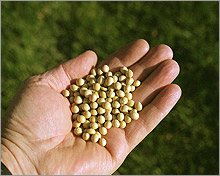 |

Biodiesel can be made from any fat or oil. Current U.S. biodiesel production is primarily from oil from soybeans such as these or from recycled restaurant cooking oil.
Here you will find frequently asked questions (FAQs) on biomass basics.
QWhat is biomass?
ABiomass is any sort of vegetation, including trees, grasses, and plant parts such as leaves, stems, and twigs. During photosynthesis, plants form carbohydrates, which form the building blocks of biomass. The solar energy that drives photosynthesis is stored in the chemical bonds of the biomass.
Related Resources
QWhat is the difference between biofuels, biopower, and bioproducts?
AIn practice, we tend to use these three different terms for three different end uses — transportation, electric power or heat, and products such as chemicals and materials. "Biofuel" is short for biomass fuel. We use the term biofuels for liquid transportation fuels, such as ethanol and biodiesel, that can be produced from biomass. We tend to use "biopower" for biomass power systems that generate electricity or industrial process heat and steam, such as combined heat and power (CHP) systems. The term "bioproduct" is short for biomass products and can be used to describe a chemical, material, or other product derived from renewable biomass resources. Renewable bioproducts are products created from plant- or crop-based resources such as agricultural crops, crop residues, and forestry residues. These products may include fabrics, plastics, and chemicals. Many of the products that could be made from renewable resources are now made from petroleum.
Related Resources
QHow much biomass is used for energy today?
AWorldwide, biomass is the fourth largest energy resource after coal, oil, and natural gas. It is used for heating (such as wood stoves in homes), cooking, transportation (fuels such as ethanol and biodiesel), and for electric power generation. Researchers estimate that there are about 278 quadrillion Btu of installed biomass capacity worldwide. According to the Energy Information Administration, U.S. biomass energy consumption was more than 2.8 quadrillion Btu in 2004.
Related Resources
|
 |






